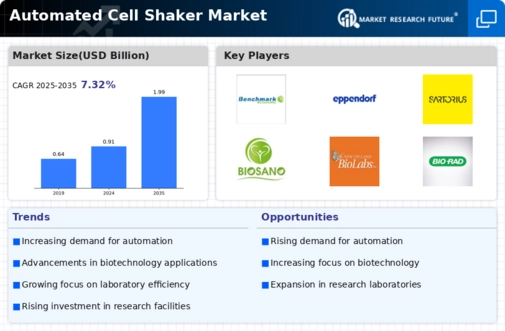Market Growth Projections
The Global Automated Cell Shaker Market Industry is projected to experience substantial growth over the next decade. With a market value of 0.91 USD Billion in 2024, it is anticipated to reach 1.99 USD Billion by 2035. This growth trajectory suggests a compound annual growth rate of 7.35% from 2025 to 2035, reflecting the increasing reliance on automated solutions in laboratory settings. The expansion of biopharmaceutical production, coupled with technological advancements, is likely to drive this growth. As the industry evolves, the demand for efficient and reliable automated cell shakers will continue to rise, shaping the future of laboratory automation.
Rising Demand for Biopharmaceuticals
The Global Automated Cell Shaker Market Industry experiences a notable surge in demand driven by the increasing production of biopharmaceuticals. As the biopharmaceutical sector expands, the need for efficient cell culture processes becomes paramount. Automated cell shakers facilitate high-throughput screening and consistent growth conditions, essential for producing monoclonal antibodies and recombinant proteins. The market is projected to reach 0.91 USD Billion in 2024, reflecting the industry's response to this growing demand. Furthermore, advancements in automation technology enhance productivity and reduce labor costs, making automated cell shakers indispensable in biopharmaceutical manufacturing.
Emerging Markets and Global Expansion
The Global Automated Cell Shaker Market Industry is experiencing expansion into emerging markets, where increasing investments in biotechnology and pharmaceutical sectors are driving demand. Countries in Asia-Pacific and Latin America are witnessing significant growth due to rising healthcare needs and government support for biotechnological advancements. This expansion is likely to create new opportunities for manufacturers of automated cell shakers, as local laboratories seek to enhance their research capabilities. The market's growth in these regions is indicative of a broader trend towards globalization in the life sciences sector, where automated solutions are becoming essential for competitive research and development.
Technological Advancements in Automation
Technological innovations play a crucial role in shaping the Global Automated Cell Shaker Market Industry. The integration of advanced features such as real-time monitoring, programmable settings, and improved energy efficiency enhances the functionality of automated cell shakers. These innovations allow for precise control over environmental conditions, which is vital for optimizing cell growth and productivity. As research institutions and laboratories increasingly adopt these technologies, the market is expected to witness a compound annual growth rate of 7.35% from 2025 to 2035. This growth trajectory indicates a strong inclination towards automation in laboratory settings, further solidifying the market's position.
Growing Adoption in Academic Institutions
The Global Automated Cell Shaker Market Industry is witnessing a growing adoption of automated cell shakers in academic institutions and research laboratories. As educational and research facilities strive to enhance their experimental capabilities, the demand for reliable and efficient cell culture equipment increases. Automated cell shakers offer the advantage of scalability and reproducibility, which are essential for academic research. This trend is further supported by funding initiatives aimed at improving laboratory infrastructure in educational settings. The integration of automated cell shakers into academic curricula enhances the training of future scientists, thereby fostering a culture of innovation and research excellence.
Increased Focus on Research and Development
The Global Automated Cell Shaker Market Industry benefits from a heightened emphasis on research and development across various sectors, including pharmaceuticals and biotechnology. Governments and private entities are investing significantly in R&D initiatives, leading to an increased demand for automated solutions that streamline laboratory processes. Automated cell shakers are integral to these R&D efforts, enabling researchers to conduct experiments with greater efficiency and reproducibility. This trend is likely to contribute to the market's growth, with projections indicating a rise to 1.99 USD Billion by 2035. The alignment of R&D investments with automation technologies underscores the importance of automated cell shakers in modern scientific endeavors.





















